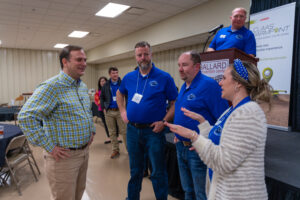Continuous improvement & evolution in a volatile, uncertain, complex and ambiguous world
Toyota, Tesla and Amazon are just a few examples of continuous improvement and evolution Patricio Frangella, head of commercial development at CLAAS FARMPOINT, used as he talked with Kentucky Young Farmers Association on March 1.
 .
. 
Companies like Toyota, Ford, Dodge and General Motors were born in a brick-and-mortar world. But Frangella went on to explain how today is a VUCA — volatile, uncertain, complex and ambiguous — world. Agriculture is no exception.
Frangella used the first CLAAS LEXION combine — the 400 series introduced in 1997 — as a perfect example of the importance of continuous improvement at CLAAS FARMPOINT. Helmut Claas knew that he had a good machine — productive, efficient, best in class — but he also knew that very same day that if he wanted to stay ahead of the competition, he needed to keep getting better, keep improving and keep introducing best-in-class products.
“He challenged his engineers and other people in the organization to find better ways to create new ideas. As a result, we saw the 500 series being released, later on the 700 series. Look ahead to today – we’re still launching LEXION combines, now with the 7000 to 8000 series,” Frangella said.
As farm machinery has evolved, farm machinery maintenance has had to evolve along with it, said Frangella.
In the last few decades, if a farmer had a bearing or belt go out in their combine during harvest, they would shut down, then they hopped in the pickup and ran to town to get a replacement part — if it’s even something they could replace or repair themselves. If the repair needs a service professional, the farmer is forced to stop harvest, probably pace a hole in the ground and wait for a technician. Either way, a lot of valuable time has been eaten away during a busy, important time of year.
“But now let’s think like Helmut Claas. Let’s think about how to evolve. What can a farmer do? Keep those common wear parts on hand and well-organized so he or she is ready. What can the dealer do? Cut down the time for getting that repair job done by putting the right people with the right tools and expertise in the right places to make sure the work’s done quickly and efficiently,” Frangella said. “We apply a digital intelligence platform like (Remote Service) to tell farmers when they need maintenance before they even think of it.”
Last harvest, CLAAS FARMPOINT reduced down time for 70 farmers by proactively contacting farmers running their combines. Frangella shared an example where — because of remote monitoring — there was a CLAAS LEXION combine in Owensboro, Ky., with a moisture sensor alarm that went off and because the FARMPOINT team was able to track the alarm and notify the customer, it prevented loss quality of grain.
“When we first started considering how we’d build FARMPOINT, we started with the traditional service model for farm machinery dealerships. Then we turned it on its head. We thought ‘How can we evolve this model to make it perform better for farmers?’,” said Frangella. “We came up with the system of On Your Farm Parts boxes, parts runners and mobile service technicians that, when all working together, keep our farmers in the field doing what they do best with less downtime.”
Change is accelerating every day, and it’s becoming more and more important to keep the pace or the growth curve will become a wall. It requires our open mindedness to consider different ways of doing things and the ability to learn new things every day.
Frangella left the group with this, “Continuous improvement and evolution are never easy and not always comfortable, but the rewards can be massive.”
